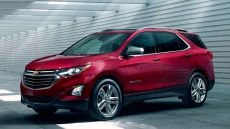Celebrating seven decades of beautiful sports cars
Jaguar is a brand that knows how to look backward in order to move ahead. For example, in recognition of its 70th anniversary of sports car production — all started by the open two-seater XK 120 — a special 2020 F-TYPE Chequered Flag variant has been launched.
This limited edition vehicle is based off the R-Dynamic trim featuring a contrast black roof, polished 20-inch alloys, Windsor leather upholstery and aluminum centre console. Available in both coupé and convertible form factors, consumers also have a choice of either the 296-horsepower 2.0-litre turbocharged or the 380-horse 3.0-litre supercharged V6 engine, the latter dubbed the P380 and equipped with all-wheel drive. We took out a hardtop packing the V6 for a week-long evaluation.

“Perfect proportions, design purity and visual drama: every Jaguar must express these qualities, and none more so than F-TYPE. In creating the Chequered Flag we’ve focused on details that enhance F-TYPE’s presence and promise of performance. And in doing so, made a fitting celebration of 70 years of beautiful, fast, Jaguar sports cars,” says director of design Ian Callum in a news release.
Callum pretty much hits the nail on the head in terms of exterior aesthetics. While I absolutely love a good drop top, there’s just something about the flowing lines of the fixed roof. The model already is a serious head turner, but the fastback body style emphasizes how wide the vehicle really is.

Details setting the latest creation apart from regular offerings are the six-spoke “6003” wheels, unique badging front and rear and in the interior, red illuminated sill plates, red brake calipers, dark finish on the aluminum console finisher. In addition, all F-TYPE grades now wear differentiating front bumper skins to distinguish between them, the corner intakes growing in size in direct relation to numbers of cylinders. The V6 is right in the middle of the pack — not too small or big.
For those thinking of stepping up into an R spec running the 550-horsepower 5.0-litre V8 motor, the cars receive enhancements to the suspension. Damping has been reduced by 24 per cent in the low range to improve ride comfort at cruising speeds, and the setup borrows the rear upper ball joint from the top-of-the-line SVR and boasts modifications to the rear knuckle and upper control arm to increase handling ability and durability.

Last year, I was fortunate to test out an eight-cylinder version and the noise coming out of the dynamic quad-exit exhaust can only be described as intoxicating. While not exactly the same, the P380 provides a worthy aural experience full of snap, crackle and pop any time drivers wind out the engine. The slightly reduced output didn’t leave me wanting, either, still very capable of causing heart palpitations at full tilt.
All 2020 F-TYPEs receive a backup camera and forward parking sensors as standard, a boon particularly when piloting the coupé as rear visibility is almost nonexistent due to the tiny rear window and significant blind spots. The Touch Pro infotainment system, is anchored around a 10-inch touchscreen. Although significantly improved with each generation in terms of response time to inputs, the lack of a rotary tuner is especially irritating while trying to navigate through 100s of satellite radio stations. At least there’s a volume knob.

Seating is supportive and comfortable as always, and as an added benefit the new “slimline” seats are constructed out of lightweight materials tipping the scales at a mere eight kilograms each.
Highlights (as tested):
MSRP: $105,000
Motor: 3.0-litre supercharged V6
Horsepower: 380 @ 6,500 rpm
Torque (lb-ft): 339 @ 3,5000 rpm
Gearbox: Eight-speed automatic
Layout: Front engine, all-wheel drive
Fuel economy: 13.9 L/100 km mixed city/highway (observed)


